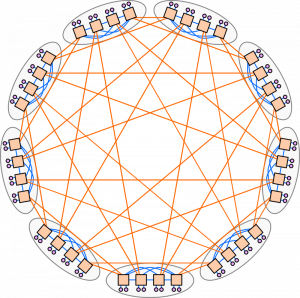H817 – 20b – Week 23 Activity 15 – Citation networks
* Note what the authors aimed to do in the paper, and what their main findings were.
The authors Dawson et al. (2014) aimed to discover a framework of sorts to make sense of the many methodologies and approaches to studying learning analytics.
They found divergence in the computing and education approaches to analytics research as reflected in the published works form the LAK conferences. The abstract also highlights the conceptual nature of the commonly references research works.
* Now turn to the practical implications of the paper (Section 4.3). Read this, and expand your notes in the form of a bullet-point list. Note which findings are linked to a practical implication.At this stage, you will have gained a sense of what the paper is about, although you have only read a couple of sections.
* Understanding how analytics evolves by documenting the key authors
* Detailing influential papers
* Raise awareness of the construction of knowledge in the field
* Development of a curriculum of academic programs (This is a practical implication)
* Promotion of under represented groups and methods
* Less reliance on overviews and conceptual papers
* Improved connections to International Educational Data Mining Society (Practical Implication)
* Note whether you think this is an example of learning analytics, according to the definition you produced in Week 21 of this module, or whether it is simply about learning analytics.
My definition :Learning analytics is “The timeous capture and analysis of institutional data sets, to inform immediate and long term decision making.”
This is not an example of learning analytics according to the definition I chose in week 21. The conclusions of this paper are more a meta study of the types of analytic study methods commonly used rather than a detailed analysis of any specific analytic data.
PART 2
The Dawson et al. (2010) paper aims to evaluate the current status of research papers concerned with the field of learning analytics. The evidence used has been gathered by studying papers produced by the Society for Learning Analytics Research (SoLAR) and Learning Analytics and Knowledge Conference (LAK).
The methods employed to carry out this analysis are citation analysis and structured mapping.
It is clear from reading this paper that the limited application of analytics (at the time of writing) in the field of learning and teaching is a motivation for the study. The use of analytics to improve organisational efficiency is mentioned as one of the few areas within which analytical data is being effectively used. The lack of easy to use analytical tools such as dashboards to monitor learning and teaching in institutions is also highlighted.
The use of limited, mostly existing data sources such as LMS and Student Information systems is noted as a barrier to truly understanding how students are doing. The simple recording of logging in times, number of activities clicked does not provide enough information to predict student outcomes and guide possible interventions.
The paper notes that learning analytics has identified a problem but has not developed to the point where complex challenges can be described and addressed. The evaluation therefore is intended to benefit future research projects.
A short list of the potential benefits suggested are assisting funding agencies to recognise worthwhile research, identifying gaps in research, improve connection between theory and practice in analytic research. There is also a hint at the existence of a clique of researchers in the analytics community.
An explanation of the purpose of citation analysis and it’s use in quality assurance is provided. The existence of citation databases are their use in identifying what the paper describes as “tribes and territories” within research circles.
The authors further go on to highlight their aims for the paper to map the most cited papers and methodologies used in analytics research.
* Write an entry in your learning journal or blog about your experience of reading a paper in this way. What do you think you gained or lost by missing out some sections?
I found the approach to analysing this paper quite useful to get an overview of what is being studied. I found I could get a general understanding of the results of the study without having to interpret all of the data.
On the other hand I think I may have missed out on some of the detailed analysis of the citation network and I would have liked to know more about the divergence of academic and computing science disciplines mentioned in the introduction.
Having glanced at some of the other sections in this paper I would conclude that it is a little beyond my current understanding or ability to absorb the complex parts of this paper.
References:
Dawson, S., Bakharia, A. and Heathcote, E. (2010) ‘SNAPP: realising the affordances of real-time SNA within networked learning environments’ in Dirckinck-Holmfeld, L., Hodgson, V., Jones, C., de Laat, M., McConnell, D. and Ryberg, T. (eds) Proceedings of the 7th International Conference on Networked Learning 2010, Aalborg, Denmark (3–4 May), Lancaster, Lancaster University, pp. 125–33 (Online). Available at http://www.networkedlearningconference.org.uk/past/nlc2010/abstracts/PDFs/Dawson.pdf (Last accessed 17th July 2020).